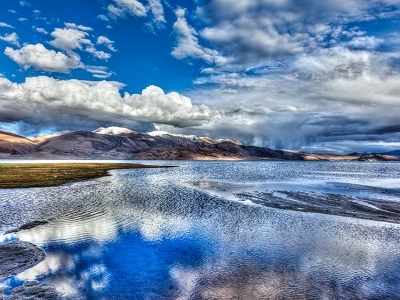Tsomoriri or Lake Moriri (official name: Tsomoriri Wetland Conservation Reserve), is lake in the Changthang (literally: northern plains) area in Kashmir. The lake is at an altitude of 4,595 m (15,075 ft); it is the largest of the high altitude lakes in the Trans-Himalayan biogeographic region, entirely within India. The lake sits between Ladakh, India to the North, Tibet to the east, and Zanskar in the west.
The lake is fed by springs and snow-melt from mountains on the Changthang plateau. Water enters the lake in two major stream systems, one entering the lake from the north, the other from the southwest. Both stream systems create extensive marshes where they enter the lake. It formerly had an outlet to the south, but this has become blocked and the lake has become land locked. As a result, the water is now becoming saline. The lake was a source of salt for local people until 1959. this is reflected in the lake’s name; Tsokar means salty lake in local language.The lake is oligotrophic in nature, and its waters are alkaline.Accessibility to the lake is limited to summer season only.
Conservation Efforts :
The need for evolving a strategy and an action plan to preserve the extreme fragility of the lake ecosystem has been recognized with the needed emphasis at the National and International level to develop the lake conservation activity with participation of all stakeholders.The actions initiated in this direction are:
Tsomoriri is an administratively declared Wetland Reserve. Legally, shooting wildlife is prohibited. The State Department of Wildlife has set up a check post near Mahe Bridge at the entrance towards the lake.WWF-India Project has established a field office at Korzok in Rupshu near Tsomoriri for ‘Conservation of High Altitude Wetlands in Ladakh Region’ to carry out surveys, interact with tourists, tour guides, act as information centre and conduct education awareness programmes for locals, tourists etc.
Wildlife Institute of India has also set up a field station at Leh to carry out scientific research in the region. Nature clubs have been set up and Information booklet on the lake published. Efforts of WWF – India has also resulted in the local community declaring Tsomoriri as a ‘Sacred Gift for a Living Planet’ during the Annual Conference held in Nepal in November 2000.
Some of the other achievements so far reported on the Lake’s conservation are:
Regulation in consultation with local community Vehicular traffic flow and parking has been restructured with restriction of camping sites around the lake
The Indo Tibetan Border Petrol (ITBP), tour operators and local population have introduced regular garbage clean up operations
Korzok community living around the lake has voluntarily built traditional and social fencing around the wetland to protect breeding and feeding grounds from vehicular traffic
Tsomoriri Conservation Trust has been set up.
Twenty Nature Clubs have been registered in different schools in Ladakh
The Indian Army has committed to support and set up a Nature Interpretation Centre at ‘Hall of Fame’, Leh.
Ramsar Site :
Largely based on the ecological diversity of the Lake (explained in the previous section) and its surroundings, the Tsomiriri was notified in November 2002 under the List of Ramsar Wetland sites under the Ramsar Convention. The justification could be summarized as:
The faunal collection is unique and has a large variety with endemic and vulnerable species
The herbivore species are also endemic to the region
The lake plays a fundamental role as breeding grounds and key staging posts on migration routes for several water birds belonging to six families, which is distinctive of wetland diversity and productivity
Avifauna and Flora :
An avifaunal survey of the Lake and its adjoining Nuro Sumdo wetland conducted in July 1996 revealed the following facts:
Thirty-four species of birds included 14 species of water birds (some are pictured in the gallery) of which following are the vulnerable species
Black-necked Cranes endangered.
Bar-headed Geese – only breeding ground in India
Brown-headed Gulls
Great Crested Grebe (rare)
Ferruginous Pochard
Black-necked Grebe (rare)
Mammalian Fauna :
Tibetan gazelle,Goa antelope (threatened)
”Lynx”
Nayan
Bharal, Himalayan blue sheep
Tibetan Ass (Kiang) or Equus kiang, endemic to the Tibetan Plateau
Great Tibetan Sheep
One species of marmot, in large numbers seen on the hill slopes surrounding the lake and also along the roadsides
One species of hare, oistolus
One species of vole,
Three species of mouse hares,Tibetan Sand Fox and ”Scincella ladacensis”

